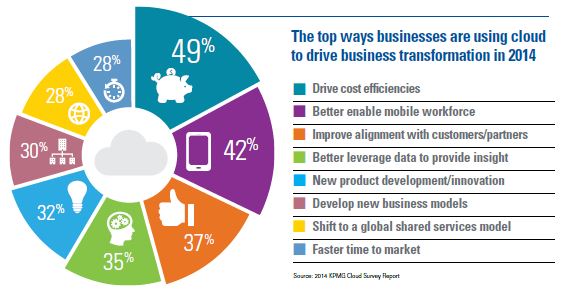Enterprise Cloud is more about Operational Efficiency than Cost Savings says KPMG
In many ways 2014 was a watershed year for the cloud and data center transformations as more and more enterprises of all sizes, but particularly larger ones, decided to test the cloud waters in part or in whole. The reasons are varied, but as a new survey from KPMG highlights, one of the biggest trends along with an increased comfort level was the shift from looking at the cloud as a way to reduce costs and a greater focus on actual business outcomes. This is a major shift in emphasis and one that is likely to pick up even more momentum in 2015.
Getting comfy with the cloud
To say the least, KPMG’s 2014 Cloud Computing Survey (PDF), is worth a download and a detailed examination. It analyzed the responses of more than 650 senior executives across 16 countries and various industries.
According to the survey, through the implementation of cloud solutions, 73 percent of enterprises were able to improve business performance, 72 percent improved service automation, and 70 percent had reduced costs. These enterprises have been able to create solutions to empower mobile workforces, and improve business processes and automate services.
The graphic below is instructive as it highlights the top ways businesses were using the cloud in 2014.
Source: KPMG 2014 Cloud Computing Survey (click to enlarge)
Study authors Steven Hill and Rick Wright said, “[A] greater focus is being placed in new areas including getting the business process redesign right, facilitating appropriate change processes and business model improvements, and moving more core functions to the cloud.”
The survey also found that as knowledge grows businesses really are becoming more comfortable with the benefits as well as the risks of the cloud and over the next 18 months will be putting their money in cloud-based business process automation as budgets for cloud projects are increased.
Cloud is being seen as more than a way of saving money, but rather as something more central to their business, and is being treated as such. “[I]n order to reap the full benefits of cloud adoption…organizations must also transform their business processes, or they run the risk of misinterpreting the short term IT savings as success, while the longer term strategic business objectives go unrealized,” Hill and Wright note.
The authors also noted that as initial adoption of cloud has been surmounted along with a mitigation of security and performance concerns, implementation including integration, operations and governance are rising to the top of the heap although the report does note that in terms of evaluating cloud-based applications and services providers the rank order of selection criteria were:
- Security (82 percent)
- Data Privacy (81 percent)
- Cost (78 percent)
However, here too thanks to experience best practices are starting to develop, which are speeding development and implementations and creating greater peace of mind with IT professionals.
There is a final cautionary yet optimistic note from the authors which while note surprising is symptomatic of all major technology transformation. Hill and Wright state that: “The resulting journey [towards Cloud] is proving more complicated and challenging than many had originally anticipated. That said, it is clear that – with greater experience and a few hard-won lessons – executives continue to believe that the benefits of cloud adoption far outweigh any growing pains that they may experience through implementation.”
The good news is that thanks to early adopters and the increasing speed of innovation, the cloud is not just here to stay but more importantly is being viewed as something more than a means for moving CAPEX to OPEX. Enterprises see the value in enabling the mobile workforce and improving both business processes and having the tools to enhance the customer experience as big cloud benefits that create differentiated and sustainable value. In short, it turns out that we appear to be out of the hype cycle and 2015 is shaping up as a very cloudy year. This means data center transformations are going to be very high on enterprises’ agendas.
Edited by Maurice Nagle
| Article comments powered by Disqus |

 By
By 
 9:30 - Wed. January 28
9:30 - Wed. January 28